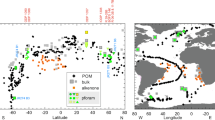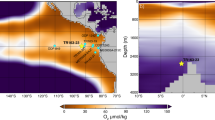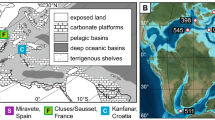Abstract
The stable isotopic composition of fossil Foraminifera has become an increasingly important tool in palaeoecological and stratigraphic studies of marine sediments1–3, prompting several studies of the factors governing the isotopic composition of living and recent Foraminifera. Many studies have documented the good agreement between the inferred depth of growth from oxygen isotopic data4–8 and the depth stratification found in plankton tows9–11. Although results have suggested disequilibrium in some species12–14, especially among the benthic species15–16, recent data from Sargasso Sea plankton tows17–19 and Indian Ocean core top sediments20,21 suggest that oxygen isotopic equilibrium is nearly achieved in many ecologically important species. In the present study, oxygen isotopic data on as many as eight species and subspecies of planktonic Foraminifera from 52 Indian Ocean core top samples permit a comprehensive comparison of the isotopic–temperature trends across the major océanographie regions of the Indian Ocean (Table 1). Several shallow-dwelling species (Globigerinoides ruber, G. sacculifer and Orbulina universa) were used as a measure of the upper 50–100 m of the water column (the mixed surface layer). Several deep-dwelling species (G. truncatulinoides (left and right coiling varieties), G. inflata, G. scitula and G. hirsuta) were used for comparison with hydrographie data from 200 to 300m depths. The results show that the isotopic difference between the shallow and deep-dwelling species is directly related to the temperature difference between the surface waters and the depth of the permanent thermocline. This isotopic–temperature relationship suggests that isotopic analyses of species which inhabit different water depths may be used to determine the thermal gradient in the upper water column during the Cenozoic.
This is a preview of subscription content, access via your institution
Access options
Subscribe to this journal
Receive 51 print issues and online access
$199.00 per year
only $3.90 per issue
Buy this article
- Purchase on Springer Link
- Instant access to full article PDF
Prices may be subject to local taxes which are calculated during checkout
Similar content being viewed by others
References
Hecht, A. D. in Foraminifera Vol. 2 (eds Hedley, G. H. & Adams, G. C.) 1–43 (Academic, London, 1976).
Van Donk, J. in Oceanic Micropaleontology (ed. Ramsay, A. T. S.) 1345–1370 (Academic, London, 1977).
Savin, S. M. A. Rev. Earth Planet. Sci. 5, 319–355 (1977).
Emiliani, C. Am. J. Sci. 252, 149–158 (1954); Science 173, 1122–1124 (1971).
Hecht, A. D. & Savin, S. M. Science 170, 69–71 (1970); J. Foram. Res. 2, 55–67 (1972).
Savin, S. M. & Douglas, R. G. Bull. geol. Soc. Am. 84, 2327–2343 (1973).
Oba, T. Tohoku Univ. Sci. Rep. 2nd Ser. (Geol) 41, 129–195 (1969).
Williams, D. F. thesis, Univ. Rhode Island (1976).
Bé, A. W. H. Micropaleontology 6, 373–392 (1960).
Bé, A. W. H. & Tolderlund, D. S. Micropaleontology 17, 297–329 (1971).
Berger, W. H. Deep-Sea Res. 16, 1–24 (1969).
Van Donk, J. thesis, Columbia Univ. (1970).
Vergnaud-Grazzini, C. Palaeogeogr., Palaeoclim., Palaeoecol. 20, 263–276 (1976).
Kahn, M. I. Oceanol. Acta. 2, 195–208 (1979).
Duplessy, J. C., Lalou, C. & Vinot, A. C. Science 168, 250–251 (1970).
Erez, J. Nature 273, 199–203 (1978).
Williams, D. F., Bé, A. W. H. & Fairbanks, R. G. Science 206, 447–449 (1979).
Williams, D. F., Bé, A. W. H. & Fairbanks, R. G. Geol. Soc. Am. Abstr. Prog. 11, 541 (1979).
Fairbanks, R. G., Wiebe, P. H. & Bé, A. W. H. Geol. Soc. Am. Abstr. Prog. 11, 422 (1979).
Williams, D. F. Trans. Am. geophys. Un. 59, 297 (1978).
Prell, W. L. & Curry, W. B. Trans. Am. Geophys. Un. 59, 298 (1978).
Prell, W. L., Hutson, W., Williams, D. F. & Bé, A. W. H. Quat. Res.(in the press).
Duplessy, J. C. in Climatic Change (ed. Gribbin, J.) 46–67 (Cambridge University Press, 1978).
Shackleton, N. J. & Vincent, E. Mar. Micropaleontol. 3, 1–13 (1978).
Wyrtki, K. Oceanographic Atlas of the International Indian Ocean Expedition (NSF, 1971).
Oceanographic office, World Atlas of Sea Surface Temperatures (H. O. Publ. No. 225, Washington, D.C., 1944); Monthly Charts of Mean, Minimum and Maximum Sea Surface Temperature of the Indian Ocean (SP-99, Washington, D.C., 1967).
Craig, H. & Gordon, L. T. in Stable Isotopes in Oceanographic Studies and Paleotemperatures (ed. Tongiorgi, A.) 9–130 (1965).
O'Neil, J. R., Clayton, R. N. & Mayeda, T. J. Chem. 51, 5547–5558 (1969).
Hutson, W. H. Geology (in the press).
Vincent, E. & Shackleton, N. J. in Memorial Volume to O. Bandy (in the press).
Imbrie, J. & Kipp, N. The Late Cenozoic Glacial Ages (ed. Turekian, K. K.) 71–182 (Yale University Press, New Haven, 1971).
Climap project, Science 191, 1131–1137 (1976).
Berger, W., Killingley, J. S. & Vincent, E. Oceanol. Acta 1, 203–216 (1978).
Curry, W. B. & Matthews, R. K. Trans. Am. geophys. Un. 58, 415 (1977).
Epstein, S., Buchsbaum, R., Lowenstam, H. A. & Urey, H. C. Bull. geol. Soc. Am. 64, 1315–1328 (1953).
Shackleton, N. J. & Opdyke, N. D. Quat. Res. 3, 39–55 (1973).
Williams, D. F., Sommer, M. A. & Bender, M. L. Earth planet. Sci. Lett. 36, 391–403 (1977).
Author information
Authors and Affiliations
Rights and permissions
About this article
Cite this article
Williams, D., Healy-Williams, N. Oxygen isotopic-hydrographic relationships among recent planktonic Foraminifera from the Indian Ocean. Nature 283, 848–852 (1980). https://doi.org/10.1038/283848a0
Received:
Accepted:
Issue Date:
DOI: https://doi.org/10.1038/283848a0
Comments
By submitting a comment you agree to abide by our Terms and Community Guidelines. If you find something abusive or that does not comply with our terms or guidelines please flag it as inappropriate.



